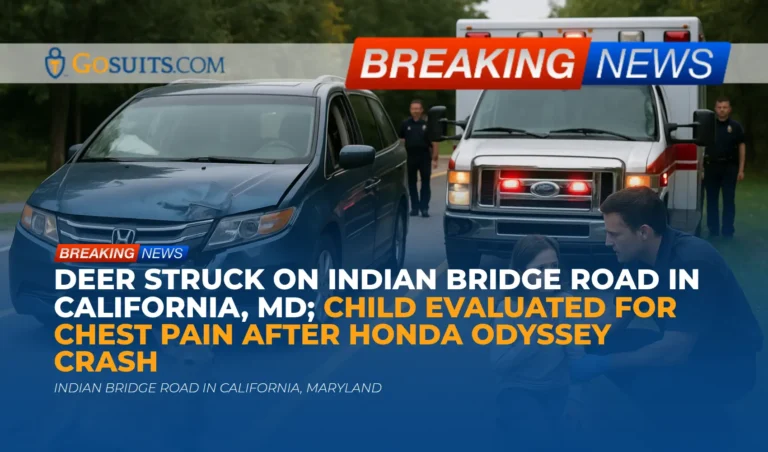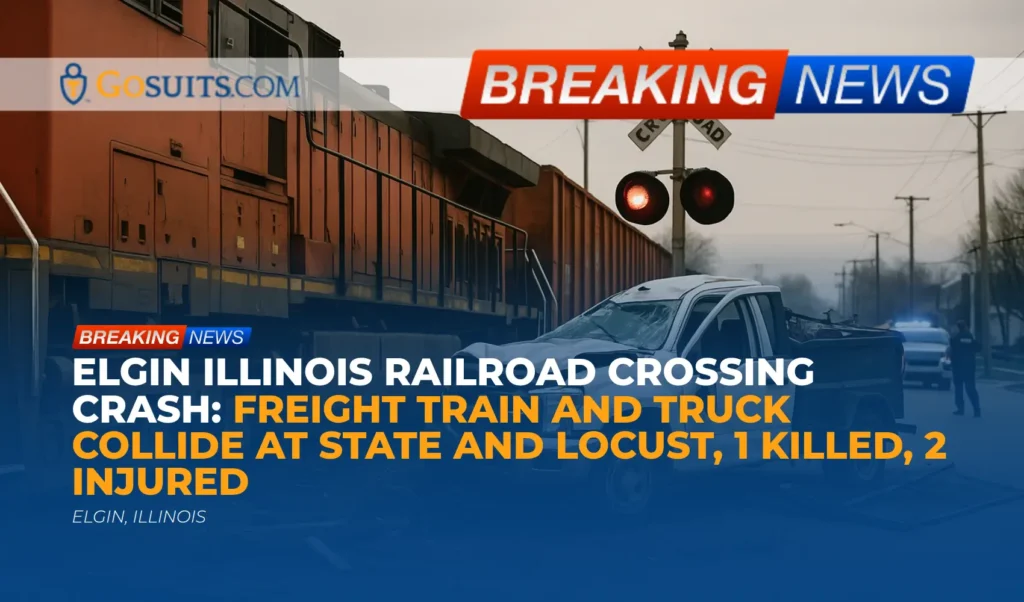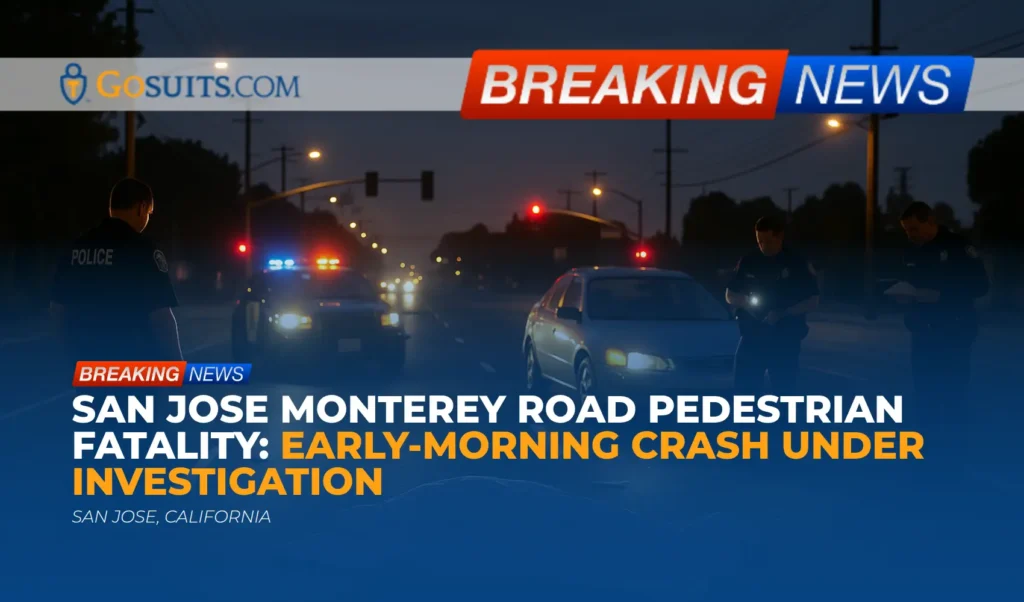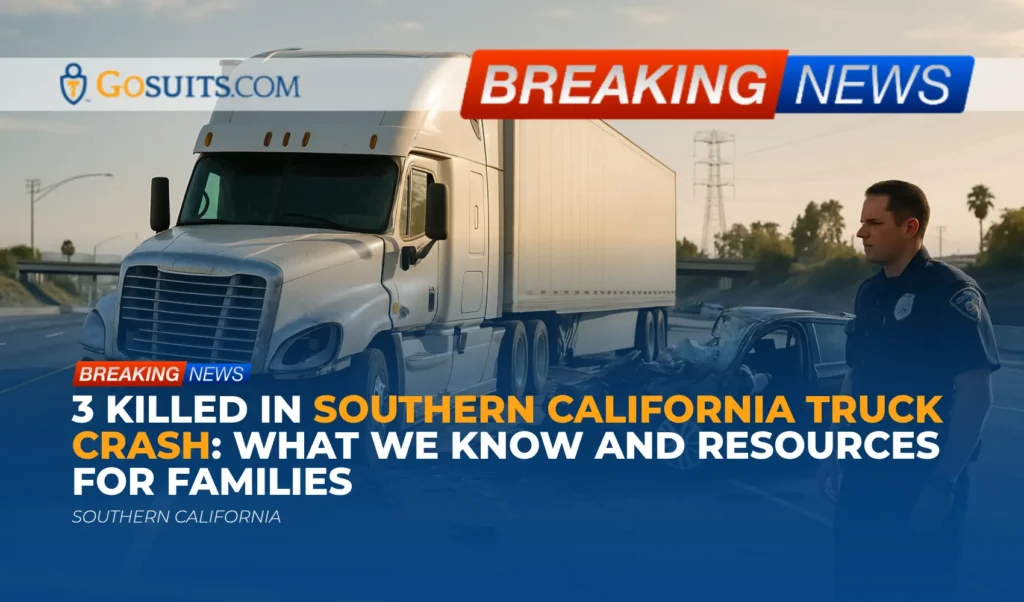- What Happened on Indian Bridge Road in California, Maryland
- What We Know So Far
- Why Deer Collisions Happen on Suburban Roads
- Child Injuries After a Deer Strike: What Families Should Know
- Immediate Steps After a Deer-Vehicle Collision
- How to Obtain Police Reports, EMS Records, and Other Official Documents
- Insurance and Claims in Maryland After an Animal Strike
- Liability Considerations in Deer Collisions
- Special Considerations for Injured Minors in Maryland
- Key Timelines and Deadlines Under Maryland Law
- Community Safety on Indian Bridge Road and Similar Corridors
- Helpful Government Resources and Contacts
- Commentary from Gosuits California, Maryland Personal Injury Attorney
- What To Do Next: Time-Sensitive Actions That Can Protect Health and Rights
What Happened on Indian Bridge Road in California, Maryland
According to publicly reported dispatch information, a vehicle struck a deer on Indian Bridge Road near the intersections with Long Bow Drive and Victorian Drive in California, Maryland. The collision was reported at approximately 8:32 a.m. on Sunday, October 19, 2025. A blue Honda Odyssey was involved. A child passenger, reported as a 9-year-old girl, experienced chest pain following the impact and required medical evaluation at the scene. Multiple emergency units responded. The deer was reported to be alive at the scene when first responders arrived. There was no immediate information on whether any patients were transported from the scene or on the full extent of injuries.
Indian Bridge Road is a suburban corridor in St. Mary’s County where deer activity is commonly observed, especially around dawn and dusk. That timing and setting are consistent with known patterns of wildlife movement that can increase the risk of animal-vehicle collisions in Maryland.
What We Know So Far
Based on the initial report, here are the essential facts available at this time:
- Location: Indian Bridge Road near Long Bow Drive and Victorian Drive, California, Maryland, St. Mary’s County.
- Time and date: About 8:32 a.m., Sunday, October 19, 2025.
- Vehicles and parties: A blue Honda Odyssey struck a deer. A 9-year-old girl reported chest pain after the collision. Another adult female was evaluated at the scene.
- Response: Multiple emergency units responded and evaluated those involved.
- Wildlife: The deer was alive at the scene immediately after the collision.
- Unknowns: Transport status, diagnosis, and the complete extent of injuries were not immediately available.
As further official information becomes available, it may clarify whether any occupants were transported to a hospital and provide details about injuries and vehicle condition. Families often find it helpful to later request official records, which are discussed in a section below.
Why Deer Collisions Happen on Suburban Roads
Maryland sees frequent deer-vehicle collisions during the fall months due to seasonal deer behavior, including breeding activity and increased movement. Wildlife tend to move more during low light conditions around dawn and dusk, which reduces driver reaction time. Deer can also travel in groups, meaning that if one crosses the road, more may follow.
The Maryland Department of Natural Resources (DNR) advises that drivers should stay alert in areas marked for deer crossings, use high beams when safe to do so, and reduce speed in low visibility. DNR and federal transportation safety research both note that braking firmly rather than swerving can reduce secondary crashes. Drivers who swerve to avoid an animal sometimes lose control or collide with other vehicles or fixed objects. For general safety guidance, see Maryland DNR’s information on deer-vehicle collisions and federal analysis on wildlife-vehicle collisions from the Federal Highway Administration.
Reliable source references for seasonal patterns and safety practices:
- Maryland DNR: Deer and Vehicle Safety
- Federal Highway Administration: Wildlife-Vehicle Collision Reduction Study
Child Injuries After a Deer Strike: What Families Should Know
Even when visible damage looks minor, a sudden deceleration can cause injuries that are not immediately obvious, particularly in children. A child describing chest pain after a collision may be experiencing anything from seat belt-related bruising to more serious internal injuries. Only a qualified medical professional can evaluate and diagnose these conditions, and timely care matters.
Safety organizations recommend keeping children properly restrained in age- and size-appropriate car seats or booster seats. Maryland law sets child passenger safety requirements, and national guidance emphasizes correct seat type and proper installation. When a collision occurs, seats should be inspected for replacement per manufacturer guidance, especially after moderate or severe crashes.
Reliable source references for child passenger safety and post-crash considerations:
- NHTSA: Child Passenger Safety
- CDC: Child Passenger Safety
- Maryland Transportation Article § 22-412.2 (Child Safety Seats)
- Maryland Department of Health: Kids In Safety Seats (KISS)
If there is any concern about symptoms after a crash such as chest pain, shortness of breath, dizziness, unusual sleepiness, vomiting, or new behavior changes in a child, seek prompt medical evaluation. Documentation from emergency medical services and hospitals will be important for both health and any insurance claim review.
Immediate Steps After a Deer-Vehicle Collision
When a vehicle strikes a deer, safety comes first. Consider the following general steps. These are not a substitute for medical or legal advice, but they can help families think through what to do next.
- Move to safety if possible: Pull off the roadway, turn on hazard lights, and stay clear of traffic. Do not approach an injured animal.
- Call 911 for any injuries: Report the location, vehicles involved, and whether anyone is hurt. Follow dispatcher instructions. EMS evaluation is important for any child reporting pain.
- Document the scene: If safe, take photos of the roadway, vehicle damage, deployed airbags, seat positions, and any visible injuries. Note the time, weather, and lighting conditions.
- Exchange information: If any other drivers are involved, exchange contact and insurance details. Obtain names of witnesses if available.
- Wait for law enforcement: A police report can be crucial for insurance and for understanding what happened.
- Preserve evidence: Keep damaged child restraints for inspection, maintain receipts, and save medical discharge papers.
- Contact an attorney before speaking with insurers: What is said to an insurance company can be used later in claim evaluation. A free consultation can help you understand your rights before you provide recorded statements.
Maryland DNR advises that injured or dead deer on roadways should be reported to authorities. Natural Resources Police or law enforcement can respond to manage wildlife hazards. See the DNR deer-vehicle page for more.
How to Obtain Police Reports, EMS Records, and Other Official Documents
Official records help establish the facts of a collision and support insurance review. In St. Mary’s County, responses may involve local law enforcement or the Maryland State Police Leonardtown Barrack, depending on jurisdiction and dispatch. Families can request records from the responsible agency once they are available.
- Police collision report: If Maryland State Police handled the scene, collision reports are generally available through the Central Records Division. The agency’s site includes request procedures and contact information. See Maryland State Police Central Records Division.
- EMS run sheet: Emergency Medical Services documentation can typically be requested from the local fire/EMS provider. Procedures vary by department. Response times, vitals, and initial assessments are often included.
- Hospital records: Medical records and imaging can be requested through the hospital’s Health Information Management department. Parents or legal guardians can request for minors, following HIPAA rules.
- 911 audio and CAD logs: Maryland’s Public Information Act governs access to certain records, with privacy considerations. The Maryland Attorney General provides guidance on requests. See Maryland Public Information Act Guidance.
- Wildlife coordination: For incidents involving injured wildlife, Maryland Natural Resources Police liaise with DNR. General information: Maryland Natural Resources Police.
- Fatal cases: If a collision involves a fatality, the Maryland Office of the Chief Medical Examiner manages death investigations and certain records. See Office of the Chief Medical Examiner.
When requesting records, have ready the date, approximate time, exact location, and the vehicles involved. A case number expedites processing if one was provided at the scene.
Insurance and Claims in Maryland After an Animal Strike
Maryland auto insurance policies differ, but some general patterns apply to wildlife collisions:
- Comprehensive coverage: Impact with an animal is typically handled under comprehensive coverage. This is separate from collision coverage, which generally applies if a driver swerves to avoid an animal and strikes another object or vehicle. Check your policy declarations for coverage and deductibles. The Maryland Insurance Administration provides consumer guidance on coverages. See Maryland Insurance Administration: Auto Insurance FAQs.
- Personal Injury Protection: Maryland policies generally include Personal Injury Protection unless it has been waived. PIP can help with medical costs and certain lost income without regard to fault, subject to policy limits and eligibility. Reference: Maryland Insurance Administration.
- Uninsured/Underinsured Motorist coverage: If another driver is involved, UM/UIM can protect occupants if that driver lacks sufficient coverage. Maryland requires UM coverage. See Maryland Insurance Administration.
Important caution: Before giving a recorded statement to any insurer, consider consulting with a qualified attorney. Early statements can be interpreted narrowly and may affect later claim evaluations. A free consultation can clarify rights and responsibilities, including how to document injuries and losses.
Medical bills for minors: PIP and health insurance coordination can be complex for children. Keep all itemized bills, Explanation of Benefits statements, and proof of out-of-pocket costs. Accurate documentation supports reimbursement and any later claim for damages.

Liability Considerations in Deer Collisions
Many deer-vehicle collisions do not involve negligence by another person. However, there are situations where liability may be examined:
- Driver conduct: If multiple vehicles are involved, investigators consider speed, following distance, and attentiveness. A rear-end collision or unsafe passing maneuver in response to an animal may raise civil fault questions.
- Vehicle condition: Faulty brakes or worn tires can worsen outcomes. Vehicle maintenance records sometimes come into play in multi-vehicle incidents.
- Product defects: In rare cases, airbag non-deployment or seat failure can contribute to injury severity. Technical evaluations are required before any conclusions are drawn.
- Roadway conditions: Claims against public entities for wildlife hazards are challenging due to sovereign immunity and notice requirements. These matters are highly fact-specific and time sensitive under Maryland law.
If a child is hurt, Maryland law treats their claims with particular care, including extended timeframes to bring civil actions. Even when a deer is the immediate cause, it can still be important to analyze whether any other party’s actions or omissions contributed to the harms suffered.
Special Considerations for Injured Minors in Maryland
Maryland’s general statute of limitations provides time limits to bring civil actions, but the clock is treated differently for minors. Under Maryland law, the limitations period is typically tolled during minority, meaning that a child’s time to file can begin at age 18. Separate deadlines can apply for related claims by parents or guardians, such as medical expenses paid on a child’s behalf or property damage.
Reliable source references for limitations rules:
Because different claims can carry different deadlines and notice requirements, it is prudent to consult with a seasoned attorney early, particularly where a minor’s injuries are involved.
Key Timelines and Deadlines Under Maryland Law
Time sensitivity follows an incident like this, even when initial injuries seem mild:
- Medical care: Timely evaluation documents injuries and supports care planning. Delays can complicate both health outcomes and insurance review.
- Preservation of evidence: Photos, vehicle inspections, and retaining child restraints can be important. Some physical evidence can be lost if a vehicle is repaired or totaled quickly.
- Insurance notice: Policies often require prompt notice. Before contacting insurers, consider speaking with an attorney to avoid statements that might be misinterpreted later. What is said to an insurance company can be used in claim evaluation.
- Civil filing deadlines: As noted, Maryland’s general three-year statute applies to many civil actions, with special rules for minors and for claims involving public entities. Consulting early helps ensure the correct deadlines are tracked.
Community Safety on Indian Bridge Road and Similar Corridors
Indian Bridge Road is a connector route where neighborhood traffic, school commuting, and wildlife movement converge. Practical steps that can improve safety include:
- Speed management: Following posted limits and moderating speed further in low-light conditions provides more reaction time.
- Scanning the roadside: Watch the shoulders and tree lines, especially near creeks and woods where deer tend to enter roadways.
- Use of high beams when safe: Improved illumination can help spot eye shine and movement at greater distances. Dim high beams for oncoming traffic.
- Brake, do not swerve: As emphasized by Maryland DNR and federal safety research, controlled braking is safer than swerving, which can cause secondary crashes.
- Expect companions: Deer often travel in groups. If one crosses, be prepared for others nearby.
- Child passenger safety checks: Ensuring that kids are in the correct seat type and properly harnessed increases protection. Maryland’s KISS program lists car seat inspection resources.
Reliable source references:
Helpful Government Resources and Contacts
Below are government resources that can assist after incidents like a deer-vehicle collision in St. Mary’s County:
- Maryland State Police: Central Records Division for collision report requests: Request Police Records
- Maryland Natural Resources Police for wildlife-related roadway hazards: Natural Resources Police
- Maryland DNR Deer-Vehicle Information for safety tips and guidance: Deer and Vehicle Safety
- Maryland Insurance Administration for auto coverage and claims guidance: Auto Insurance FAQs
- Maryland Department of Health KISS program for child seat resources: Kids In Safety Seats
- Maryland Office of the Chief Medical Examiner for fatality investigations and records in wrongful death cases: OCME Maryland
- Maryland Public Information Act Guidance for requesting public records such as 911 audio or CAD logs: Maryland Attorney General: PIA
Local agencies in St. Mary’s County, including law enforcement and EMS providers, can also advise on how to request their records. Procedures can vary by department, so calling the records unit or checking the agency’s official site is a helpful first step.
Commentary from Gosuits California, Maryland Personal Injury Attorney
Our hearts go out to the child and family affected by the deer collision on Indian Bridge Road. A sudden crash is frightening, and it is especially difficult when a child reports pain afterward. This commentary is offered for educational purposes and general information to help the community understand safety, records, and insurance considerations that often follow an animal-vehicle collision.
From a civil injury perspective, deer strikes can be complex even when there is no second vehicle. The immediate cause may be the animal entering the road, but the overall impact on a family can include medical bills, time away from school and work, and the need to replace child safety seats or repair a vehicle. Where multiple vehicles are involved or evasive actions lead to a secondary crash, questions of liability and insurance coverage can arise. Careful documentation, prompt medical evaluation, and a clear understanding of available coverages are critical.
Insurance carriers and large corporations process claims every day and rely on policy language and internal procedures that the average person sees only rarely. There can be pressure to give a quick recorded statement, accept an early settlement, or agree to vehicle total loss without a full accounting of costs. Statements made early can be used to narrow the claim later. Families benefit from clearing up policy details first, including whether PIP applies, whether comprehensive will cover the animal impact, and how medical bills for a child will be handled. Speaking with a seasoned lawyer before engaging with insurers can reduce the chance of misunderstandings and help organize the documentation insurers require.
A free consultation is a practical first step to understand timelines, evidence preservation, and the interaction between medical care and insurance coverage. It does not commit anyone to a particular course and can help set expectations about what to track and when to act, including important differences in deadlines for minors compared with adults.

What To Do Next: Time-Sensitive Actions That Can Protect Health and Rights
This section explains why it is important to act promptly after an animal-vehicle collision and what steps to consider taking now.
- Prioritize medical follow-up: Schedule timely evaluation for anyone reporting symptoms, especially children. Documentation supports appropriate treatment and confirms any activity restrictions. Acting now helps identify issues that may not have been obvious at the scene.
- Secure the child seat for review: Do not discard the car seat or booster until you confirm whether replacement is recommended after a crash. Keeping the seat available allows inspection and preserves evidence if needed later.
- Organize your records: Start a file with the police incident number, EMS run sheet, discharge summaries, imaging reports, invoices, and repair estimates. Having these materials ready shortens later review times and reduces back-and-forth with insurers.
- Document vehicle condition before repairs: Take detailed photos and consider requesting a copy of the body shop’s pre-repair inspection and any airbag module reports. Once repairs begin or a vehicle is totaled, information can be lost.
- Consult a qualified attorney before insurer contact: Talk with a lawyer about coverage, PIP, and how to handle recorded statements. What is said to an insurance company can be used in claim evaluation. A free consultation helps clarify which details to provide and which documents to gather first.
- Notify insurers within policy timeframes: Policies require prompt notice of loss. After obtaining legal guidance, report the claim to preserve coverage. This is especially important where comprehensive coverage may apply to animal impacts.
- Calendar deadlines: Note civil deadlines that may apply, including different rules for minors. Acting now prevents missed time limits and allows a thorough review of any potential claims.
- Request official records: Place requests for the police report and EMS records as soon as they are available. Records processing can take time, and having the report number handy speeds things up.
Acting promptly helps protect health, preserves important information, and ensures that time-sensitive requirements are met. Early, organized steps can make later decisions easier and more informed.
Sources and Government Guidance
- Maryland Department of Natural Resources: Deer and Vehicle Safety
- Federal Highway Administration: Wildlife-Vehicle Collision Reduction Study
- National Highway Traffic Safety Administration: Child Passenger Safety
- Centers for Disease Control and Prevention: Child Passenger Safety
- Maryland Insurance Administration: Auto Insurance FAQs
- Maryland State Police: Central Records Division
- Maryland Department of Health: Kids In Safety Seats
- Maryland Office of the Chief Medical Examiner
- Maryland Attorney General: Public Information Act Guidance
- Md. Code, Courts and Judicial Proceedings § 5-101
- Md. Code, Courts and Judicial Proceedings § 5-201






